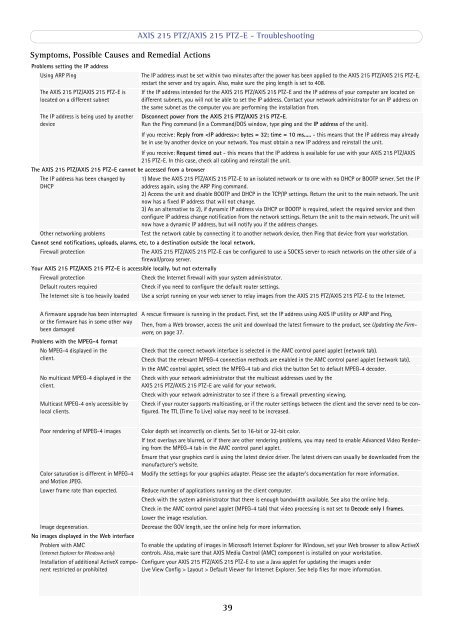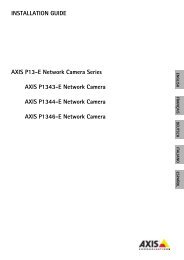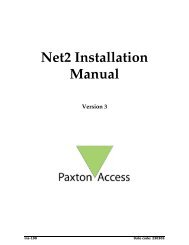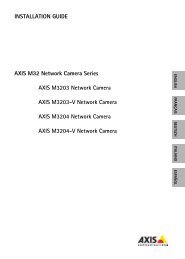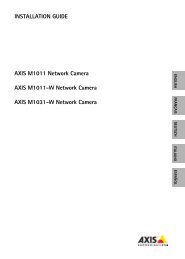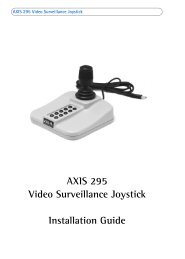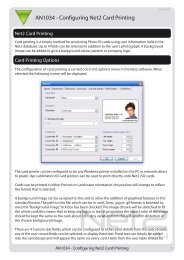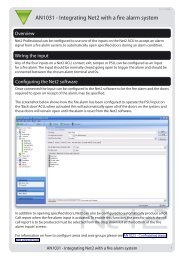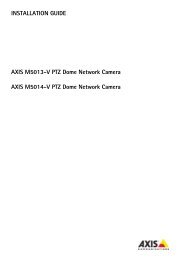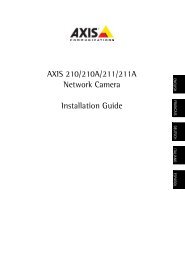Create successful ePaper yourself
Turn your PDF publications into a flip-book with our unique Google optimized e-Paper software.
Symptoms, Possible Causes and Remedial ActionsProblems setting the IP addressUsing ARP PingThe AXIS <strong>215</strong> PTZ/AXIS <strong>215</strong> PTZ-E islocated on a different subnetThe IP address is being used by anotherdeviceThe AXIS <strong>215</strong> PTZ/AXIS <strong>215</strong> PTZ-E cannot be accessed from a browserThe IP address has been changed byDHCPAXIS <strong>215</strong> PTZ/AXIS <strong>215</strong> PTZ-E - TroubleshootingThe IP address must be set within two minutes after the power has been applied to the AXIS <strong>215</strong> PTZ/AXIS <strong>215</strong> PTZ-E,restart the server and try again. Also, make sure the ping length is set to 408.If the IP address intended for the AXIS <strong>215</strong> PTZ/AXIS <strong>215</strong> PTZ-E and the IP address of your computer are located ondifferent subnets, you will not be able to set the IP address. Contact your network administrator for an IP address onthe same subnet as the computer you are performing the installation from.Disconnect power from the AXIS <strong>215</strong> PTZ/AXIS <strong>215</strong> PTZ-E.Run the Ping command (in a Command/DOS window, type ping and the IP address of the unit).If you receive: Reply from : bytes = 32; time = 10 ms..... - this means that the IP address may alreadybe in use by another device on your network. You must obtain a new IP address and reinstall the unit.If you receive: Request timed out - this means that the IP address is available for use with your AXIS <strong>215</strong> PTZ/AXIS<strong>215</strong> PTZ-E. In this case, check all cabling and reinstall the unit.1) Move the AXIS <strong>215</strong> PTZ/AXIS <strong>215</strong> PTZ-E to an isolated network or to one with no DHCP or BOOTP server. Set the IPaddress again, using the ARP Ping command.2) Access the unit and disable BOOTP and DHCP in the TCP/IP settings. Return the unit to the main network. The unitnow has a fixed IP address that will not change.3) As an alternative to 2), if dynamic IP address via DHCP or BOOTP is required, select the required service and thenconfigure IP address change notification from the network settings. Return the unit to the main network. The unit willnow have a dynamic IP address, but will notify you if the address changes.Test the network cable by connecting it to another network device, then Ping that device from your workstation.Other networking problemsCannot send notifications, uploads, alarms, etc, to a destination outside the local network.Firewall protectionThe AXIS <strong>215</strong> PTZ/AXIS <strong>215</strong> PTZ-E can be configured to use a SOCKS server to reach networks on the other side of afirewall/proxy server.Your AXIS <strong>215</strong> PTZ/AXIS <strong>215</strong> PTZ-E is accessible locally, but not externallyFirewall protectionCheck the Internet firewall with your system administrator.Default routers requiredCheck if you need to configure the default router settings.The Internet site is too heavily loaded Use a script running on your web server to relay images from the AXIS <strong>215</strong> PTZ/AXIS <strong>215</strong> PTZ-E to the Internet.A firmware upgrade has been interruptedor the firmware has in some other waybeen damagedProblems with the MPEG-4 formatNo MPEG-4 displayed in theclient.No multicast MPEG-4 displayed in theclient.Multicast MPEG-4 only accessible bylocal clients.A rescue firmware is running in the product. First, set the IP address using AXIS IP utility or ARP and Ping,Then, from a Web browser, access the unit and download the latest firmware to the product, see Updating the Firmware,on page 37.Check that the correct network interface is selected in the AMC control panel applet (network tab).Check that the relevant MPEG-4 connection methods are enabled in the AMC control panel applet (network tab).In the AMC control applet, select the MPEG-4 tab and click the button Set to default MPEG-4 decoder.Check with your network administrator that the multicast addresses used by theAXIS <strong>215</strong> PTZ/AXIS <strong>215</strong> PTZ-E are valid for your network.Check with your network administrator to see if there is a firewall preventing viewing.Check if your router supports multicasting, or if the router settings between the client and the server need to be configured.The TTL (Time To Live) value may need to be increased.Poor rendering of MPEG-4 imagesColor saturation is different in MPEG-4and Motion JPEG.Lower frame rate than expected.Image degeneration.No images displayed in the Web interfaceProblem with AMC(Internet Explorer for Windows only)Installation of additional ActiveX componentrestricted or prohibitedColor depth set incorrectly on clients. Set to 16-bit or 32-bit color.If text overlays are blurred, or if there are other rendering problems, you may need to enable Advanced Video Renderingfrom the MPEG-4 tab in the AMC control panel applet.Ensure that your graphics card is using the latest device driver. The latest drivers can usually be downloaded from themanufacturer's website.Modify the settings for your graphics adapter. Please see the adapter's documentation for more information.Reduce number of applications running on the client computer.Check with the system administrator that there is enough bandwidth available. See also the online help.Check in the AMC control panel applet (MPEG-4 tab) that video processing is not set to Decode only I frames.Lower the image resolution.Decrease the GOV length, see the online help for more information.To enable the updating of images in Microsoft Internet Explorer for Windows, set your Web browser to allow ActiveXcontrols. Also, make sure that AXIS Media Control (AMC) component is installed on your workstation.Configure your AXIS <strong>215</strong> PTZ/AXIS <strong>215</strong> PTZ-E to use a Java applet for updating the images underLive View Config > Layout > Default Viewer for Internet Explorer. See help files for more information.39


